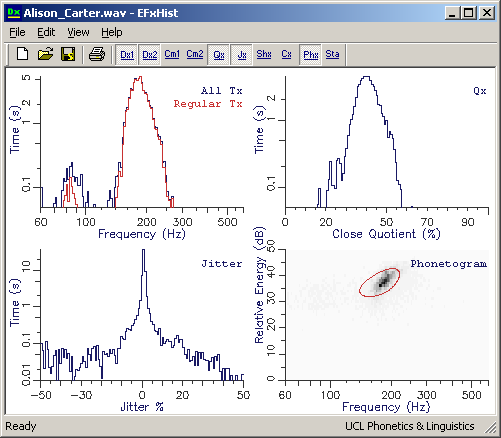
SFS/EFXHIST
Windows Tool for Fundamental Frequency Analysis
EFXHIST is a free program for the analysis of jointly-recorded speech and Laryngograph® signals. EFXHIST calculates the locations of every pitch period in the recording using the Laryngograph® signal then produces statistics of voicing, fundamental frequency, closed quotient, jitter, shimmer, etc.

Currently supported analyses are: Dx1, Dx2, Cumulative Dx1, Cumulative Dx2, Closed-Quotient, Jitter, Shimmer, Crossplot, Phonetogram, Harmonic-Noise Ratio, and Long-term Spectrum. A summary statistics table is also provided which can be copied to the clipboard. Distributions can also be imported into Excel or similar programs.
Version 2.0 beta now supports 24-bit and 32-bit samples.
Read the EFXHIST help file on-line.
Download and Installation
SFS/EFXHIST is only available from:
- https://www.phon.ucl.ac.uk/downloads/sfs/efxhist/efxhist180.exe Version 1.8
- https://www.phon.ucl.ac.uk/downloads/sfs/efxhist/efxhist200beta.exe Version 2.0beta
Download the file called efxhistddd.exe into a temporary directory. Then find and run the file to unpack and install.
Want to learn more?
If you find the study of speech interesting, why not visit the Internet Institute of Speech and Hearing at www.speechandhearing.net ? There you will find tutorials, laboratory experiments, reference material, and details of e-mail lists and discussion groups.
Feedback
Please send suggestions for improvements and reports of program faults to sfs@pals.ucl.ac.uk.
Please note that we are unable to provide help with the use of this program.
Copyright
EFXHIST is not public domain software, its intellectual property is owned by Mark Huckvale, University College London. However EFXHIST may be used and copied without charge as long as the program and help file remain unmodified and continue to carry this copyright notice. Please contact the author for other licensing arrangements. EFXHIST carries no warranty of any kind, you use it at your own risk.


